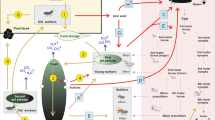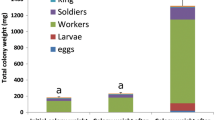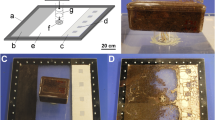Summary
Studies with Nasutitermes and Rhynchotermes (Isoptera, Nasutitermitinae) in a Costa Rican rainforest suggest that nitrogen fixation by gut symbionts may play a significant role in termite nutrition. Leaf-litter feeders ingest more and fix less nitrogen than do wood-litter feeders; both species feed preferentially on N-rich foods in their foraging repertoire. Unusually high N2 fixation (acetylene reduction) rates were found in Nasutitermes soldiers, thereby reducing their nutritional dependence on workers. Finally, N2 fixation rates of termites diminished rapidly within 24 h after removal of a colony from the field, underlining the importance of conducting future N2 fixation studies under field conditions.
Similar content being viewed by others
References
Benemann JR (1973) Nitrogen fixation in termites. Science 181:164–165
Bentley BL, Carpenter EJ (1979) Nitrogen fixation by epiphylls in a tropical rainforest: preliminary report. Tropical Ecology (in press)
Bentley BL (1980) The effects of desiccation and rehydration on nitrogen fixation by epiphylls in a tropical rainforest. Microbial Ecology (in press)
Breznak JA, Brill WJ, Mertins JW, Coppel HC (1973) Nitrogen fixation in termites. Nature 244:577–580
Breznak JA (1975) Symbiotic relationships between termites and their intestinal microbiota. In: Symbiosis (DH Jennings and DL Lee, (eds)) University Press, Cambridge p 559–580
Carpenter EJ, Culliney JL (1975) Nitrogen fixation in marine shipworms. Science 187:551–552
Collins NM (1979) Observations on the foraging activity of Hospitalitermes umbrinus (Haviland) (Isoptera; Termitidae) in the Gunong Mulu National Park Sarawak. Ecol Entomol 4:231–238
Cowling EB, Merrill W (1966) Nitrogen in wood and its role in wood deterioration. Can J Bot 44:1539–1554
Eutick ML, O'Brien RW, Slaytor M (1978) Bacteria from the gut of Australian termites. Appl Environ Microbiol 35:823–828
French JRJ, Turner GL, Bradbury JF (1976) Nitrogen fixation by bacteria from hindgut of termites. J Gen Microbiol 95:202–206
Hardy RWF, Holsten RD, Jackson EK, Burns RC: (1968) The acetylene-ethylene assay for N2 fixation: laboratory and field evaluation. Plant Physiol. 43:1185–1207
Haverty MI (1977) The proportion of soldiers in termite colonies: a list and a bibliography. Sociobiology 2:199–216
Hungate RE (1941) Experiments on the nitrogen economy of termites. Ann Entomol Soc Amer 34:467–489
Krishna K (1970) Taxonomy, phylogeny and distribution of termites. In: Biology of Termites K Krishna, FM Weesner (eds) Academic Press, New York, p 127–153
LaFage JP, Nutting WL (1978) Nutrient dynamics of termites. In Production Ecology of Ants and Termites MV Brian (ed), Cambridge University Press, Cambridge, p 165–232
Martin MM (1979) Biochemical implications of insect mycophagy. Biol Rev 54:1–21
Mathews AGA (1977) Studies on termites from the Mato Grosso State, Brazil. Rio de Janiero: Academia Brasileira de Ciencias
Matsumura F, Coppel HC, Tai A (1968) Isolation and identification of termite trail-following pheromone. Nature 219:963–964
Mauldin JK, Smythe RV (1973) Protein-bound amino acid content of normally and abnormally faunated Formosan termites, Coptotermes formosanus. J Insect Physiol 19:1955–1960
Oster GF, Wilson EO (1978) Caste and Ecology in the Social Insects. Princeton University Press, Princeton
Postgate JR (1971) The acetylene test for nitrogenase. In: The Chemistry and Biochemistry of Nitrogen Fixation. JR Postgate, (ed), Plenum Press, New York, p 311–415
Potrikus CJ, Breznak JA (1977) Nitrogen-fixing Enterobacter agglomerans isolated from guts of wood-eating termites. Appl Environ Microbiol 33:392–399
Potrikus CJ, Breznak JA (1980) Uric acid in wood-eating termites. Insect Biochem 10:19–27
Prestwich GD (1979) Interspecific variation in the defence secretion of Nasutitermes soldiers. Biochem System Ecol 7:211–221
Sands WA (1969) The association of termites and fungi. In: Biology of Termites. K Krishna FM Weesner (eds). Academic Press, New York, p 495–524
Spears BM, Ueckert DN (1976) Survival and food consumption by the desert termite Gnathamitermes tubiformans in relation to dietary nitrogen sources and levels. Environ Entomol 5:1022–1025
Sylvester-Bradley R, Bandeira AG, Oliveira LA (1978) Fixaçao de nitrogênio (reduçao de acetileno) em cupins (Insecta: Isoptera) da Amazonica Central. Acta Amazonica 8:621–627
Wood TG (1978) Food and feeding habits of termites. In: Production Ecology of Ants and Termites MV Brian (ed), University Press, Cambridge, p 55–80
Author information
Authors and Affiliations
Rights and permissions
About this article
Cite this article
Prestwich, G.D., Bentley, B.L. & Carpenter, E.J. Nitrogen sources for neotropical nasute termites: Fixation and selective foraging. Oecologia 46, 397–401 (1980). https://doi.org/10.1007/BF00346270
Received:
Issue Date:
DOI: https://doi.org/10.1007/BF00346270




